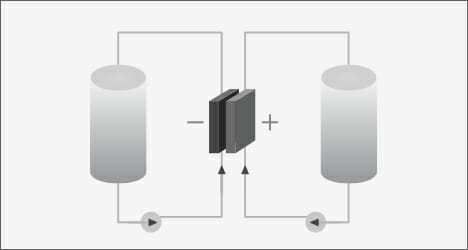Energy storage plays a key role in many types of energy projects. For instance, as powerful batteries have gotten less expensive, more distributed and utility-scale solar projects include significant amounts of storage. A recent Bloomberg article notes that the cost of lithium-ion batteries have gone down by 85% since 2010. However, lithium-ion is not the only battery technology available. At Blymyer Engineers, we’re finding that more clients are asking about flow batteries, and with good reason.
“There’s industry buzz around flow batteries at the moment,” says Blymyer President Mike Rantz. “They have the potential to have a lower total cost of ownership. The safety profile is appealing to many operators as well. On the downside, flow batteries require more management and maintenance over their lifecycles. Flow battery systems have more mass relative to their output, too.”
Flow battery and lithium-ion battery basics
A flow battery takes advantage of the differences in oxidation states of elements to store energy. An electrolyte flows through the system to charge or discharge power. The electrolyte is usually mostly water. Energy is actually stored separately from the part of the system that produces power—just as when a generator that burns fuel is separate from the tank that stores fuel.
With a lithium-ion battery, lithium-ions move between positive and negative electrodes to charge and discharge. Lithium-ion batteries can deliver substantial power relative to their size. They have an advantage in uses where portability is a priority, such in cars and laptops. On the downside, they can present fire concerns, especially as the batteries degrade.
Weighing competing factors
When choosing between flow batteries and lithium-ion, here are a few factors to consider:
• Safety: Flow batteries are less flammable than lithium-ion. This is not only a day-to-day safety plus, it reduces some of the complexity, like spacing and enclosures, associated with the large-scale use of lithium-ion batteries. Maintenance may also be safer.
• Cost of ownership: Flow batteries may last longer than lithium-ion. From an engineering perspective, there are many factors that support this idea, but much of the actual testing has come from flow battery manufacturers.
• Environmental impact: There is growing concern about the environmental impact of lithium-ion batteries. Flow batteries have a more sustainability-friendly profile, and longer life is a contributor.
• Your specific needs: Every project has its cost and performance goals, and every project site has space and safety considerations. A distributed solar project with limited space available for storage and infrequent throughput might be an ideal candidate for lithium-ion. On the other hand, a utility-scale project with few space constraints and ambitious cost-of-ownership goals might be well suited to flow batteries.
“In our opinion, flow batteries may not be a good fit for every project, but they are worth exploring,” says Rantz. “Lithium-ion dominates the market at the moment. The characteristics of flow batteries present an interesting alternative. The Blymyer team welcomes the opportunity to discuss our experience with both. We continue to research and monitor the capabilities of flow cell batteries”
